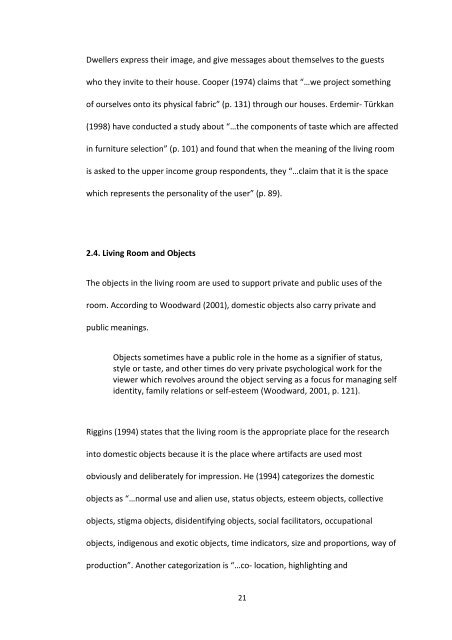private and public use of the living room - Bilkent University
private and public use of the living room - Bilkent University
private and public use of the living room - Bilkent University
You also want an ePaper? Increase the reach of your titles
YUMPU automatically turns print PDFs into web optimized ePapers that Google loves.
Dwellers express <strong>the</strong>ir image, <strong>and</strong> give messages about <strong>the</strong>mselves to <strong>the</strong> guests<br />
who <strong>the</strong>y invite to <strong>the</strong>ir ho<strong>use</strong>. Cooper (1974) claims that “…we project something<br />
<strong>of</strong> ourselves onto its physical fabric” (p. 131) through our ho<strong>use</strong>s. Erdemir- Türkkan<br />
(1998) have conducted a study about “…<strong>the</strong> components <strong>of</strong> taste which are affected<br />
in furniture selection” (p. 101) <strong>and</strong> found that when <strong>the</strong> meaning <strong>of</strong> <strong>the</strong> <strong>living</strong> <strong>room</strong><br />
is asked to <strong>the</strong> upper income group respondents, <strong>the</strong>y “…claim that it is <strong>the</strong> space<br />
which represents <strong>the</strong> personality <strong>of</strong> <strong>the</strong> <strong>use</strong>r” (p. 89).<br />
2.4. Living Room <strong>and</strong> Objects<br />
The objects in <strong>the</strong> <strong>living</strong> <strong>room</strong> are <strong>use</strong>d to support <strong>private</strong> <strong>and</strong> <strong>public</strong> <strong>use</strong>s <strong>of</strong> <strong>the</strong><br />
<strong>room</strong>. According to Woodward (2001), domestic objects also carry <strong>private</strong> <strong>and</strong><br />
<strong>public</strong> meanings.<br />
Objects sometimes have a <strong>public</strong> role in <strong>the</strong> home as a signifier <strong>of</strong> status,<br />
style or taste, <strong>and</strong> o<strong>the</strong>r times do very <strong>private</strong> psychological work for <strong>the</strong><br />
viewer which revolves around <strong>the</strong> object serving as a focus for managing self<br />
identity, family relations or self-esteem (Woodward, 2001, p. 121).<br />
Riggins (1994) states that <strong>the</strong> <strong>living</strong> <strong>room</strong> is <strong>the</strong> appropriate place for <strong>the</strong> research<br />
into domestic objects beca<strong>use</strong> it is <strong>the</strong> place where artifacts are <strong>use</strong>d most<br />
obviously <strong>and</strong> deliberately for impression. He (1994) categorizes <strong>the</strong> domestic<br />
objects as “…normal <strong>use</strong> <strong>and</strong> alien <strong>use</strong>, status objects, esteem objects, collective<br />
objects, stigma objects, disidentifying objects, social facilitators, occupational<br />
objects, indigenous <strong>and</strong> exotic objects, time indicators, size <strong>and</strong> proportions, way <strong>of</strong><br />
production”. Ano<strong>the</strong>r categorization is “…co- location, highlighting <strong>and</strong><br />
21
















